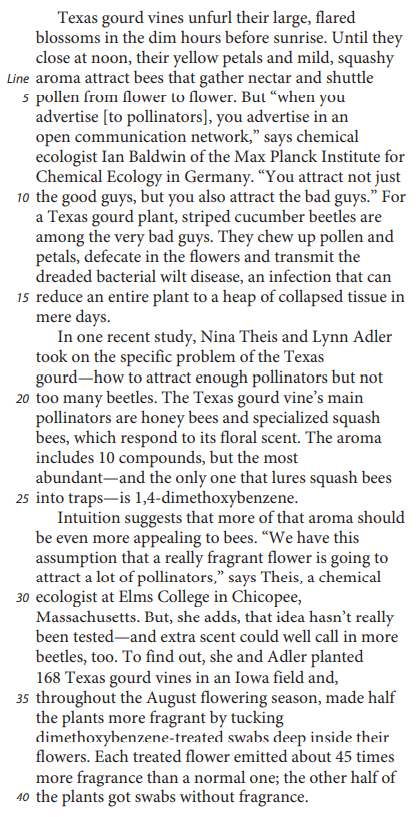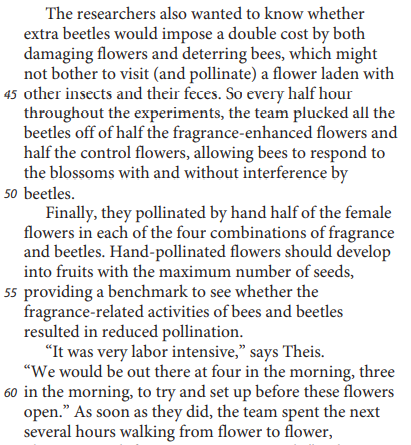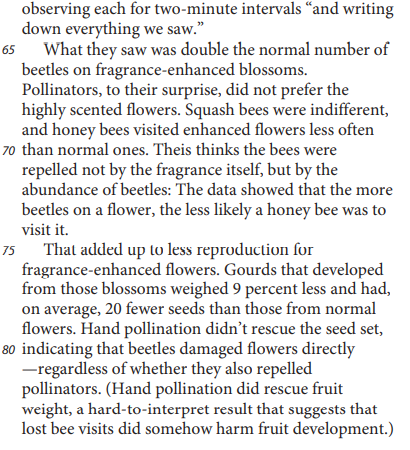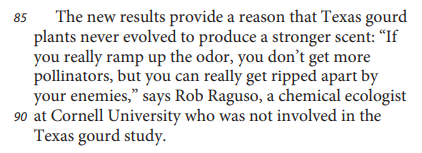SAT (Scholastic Assessment Test) is a standard test, used for taking admission to undergraduate programs of universities or colleges of the United States. SAT is developed and published by the College Board, an organization in the United States, administered by the Educational Testing Service. In this article of AKVTutorials, you will get Princeton SAT Prep Course Book Review | Practice Test 28 AMBiPi.
Princeton SAT Prep Course Book Review
The Princeton Review for SAT Premium Book review is given in the article Click Here.
Check Price On Amazon
SAT Reading Practice Passage
This passage is adapted from Elsa Youngsteadt, “Decoding a Flower’s Message.” ©2012 by Sigma Xi, The Scientific Research Society.




SAT Reading Comprehension Practice Test Questions
SAT Practice Test 28 Question No 1
The primary purpose of the passage is to
Option A: discuss the assumptions and reasoning behind a theory.
Option B: describe the aim, method, and results of an experiment.
Option C: present and analyze conflicting data about a phenomenon.
Option D: show the innovative nature of a procedure used in a study.
SAT Practice Test 28 Answer No 1
Show/Hide Answer
Option B :
The first paragraph of the passage identifies and describes “Texas gourd vines” (line 1), but the primary focus of the passage is introduced in the first sentence of the second paragraph: “In one recent study, Nina Theis and Lynn Adler took on the specific problem of the Texas gourd—how to attract enough pollinators but not too many beetles” (lines 17-20). The remainder of the passage focuses on describing the purpose, process, and results of the recent research done on those Texas gourd vines.
Choice A is incorrect because the passage doesn’t focus on the assumptions behind a theory but rather on how that theory was tested. Choice C is incorrect because the passage does not present many conflicting data; most of it supports the idea there can be too much fragrance for the Texas gourd vine. Choice D is incorrect because the passage explains the procedures used in a study were “’ very labor intensive’” (line 58) but does not present them as particularly innovative.
SAT Practice Test 28 Question No 2
As presented in the passage, Theis and Adler’s research primarily relied on which type of evidence?
Option A: Direct observation
Option B: Historical data
Option C: Expert testimony
Option D: Random sampling
SAT Practice Test 28 Answer No 2
Show/Hide Answer
Option A :
The passage says that to test their hypothesis, the scientists “planted 168 Texas gourd vines in an Iowa field” (lines 33-34) and then ultimately walked “from flower to flower, observing each for two-minute intervals” (lines 62-63). Because they gathered data by looking at and studying the plants in question, the scientists’ research is best characterized as relying on direct observation.
Choices B, C, and D are incorrect because lines 62-63 make clear that the research emphasized direct observation, not historical data (choice B), expert testimony (choice C), or random sampling (choice D).
SAT Practice Test 28 Question No 3
Which statement about striped cucumber beetles can most reasonably be inferred from the passage?
Option A: They feed primarily on Texas gourd plants.
Option B: They are less attracted to dimethoxybenzene than honey bees are.
Option C: They experience only minor negative effects as a result of carrying bacterial wilt disease.
Option D: They are attracted to the same compound in Texas gourd scent that squash bees are.
SAT Practice Test 28 Answer No 3
Show/Hide Answer
Option D :
The passage states that by using the smell of their nectar to lure pollinators like bees, Texas gourd vines are employing an “’ open communication network’” that attracts “’ not just the good guys, but . . . also . . . the bad guys’” (lines 7-10). Because cucumber beetles are then identified as some of “the very bad guys” (line 12) as far as the Texas gourd plant is concerned, it can be inferred that both the beetles and the bees are attracted to the same scent.
Choices A and C are incorrect because they are not supported by the text; the passage states that cucumber beetles “chew up pollen and petals” (lines 12-13) from the Texas gourd vines but not that those vines are their “primary” food source, and the passage does not address any effects, positive or negative, that cucumber beetles experience as a result of carrying bacterial wilt disease. Choice B is incorrect because the passage states that treating the Texas gourd vines with dimethoxybenzene led to “double the normal number of beetles” (lines 65-66) but that pollinators like bees “did not prefer” (line 67) the treated flowers, which implies that cucumber beetles are not less attracted but more attracted
to dimethoxybenzene than honey bees are.
SAT Practice Test 28 Question No 4
The author indicates that it seems initially plausible that Texas gourd plants could attract more pollinators if they
Option A: did not have aromatic flowers.
Option B: targeted insects other than bees.
Option C: increased their floral scent.
Option D: emitted more varied fragrant compounds.
SAT Practice Test 28 Answer No 4
Show/Hide Answer
Option C :
The author indicates that it is reasonable to think that the Texas gourd plants might lure more pollinators if their smell was stronger. This is clear from lines 26-27, which state that “intuition suggests that more of that aroma should be even more appealing to bees.”
Choices A and D are incorrect because lines 26-27 support the idea that it was initially thought that Texas gourd vines could lure more pollinators through “more of that aroma,” not by lacking an aroma (choice A) or giving off a more varied aroma (choice D). Choice B is incorrect because bees are the only pollinators specifically discussed in the passage, and no suggestion targeting other insects would attract more bees.
SAT Practice Test 28 Question No 5
As used in line 38, “treated” most nearly means
Option A: altered.
Option B: restored.
Option C: provided.
Option D: preserved.
SAT Practice Test 28 Answer No 5
Show/Hide Answer
Option A :
The passage explains that as part of their research the scientists “made half the plants more fragrant by tucking dimethoxybenzene-treated swabs deep inside their flowers. Each treated flower emitted about 45 times more fragrance than a normal one” (lines 35-39). In this context, a flower that was “treated” would be one that was changed or altered.
Choices B, C, and D are incorrect because in the context of a flower having a compound like dimethoxybenzene added to it, the word “treated” means changed or altered, not returned to normal (choice B), given (choice C), or kept for future use (choice D).
SAT Practice Test 28 Question No 6
What did Theis and Adler do as part of their study that most directly allowed Theis to reason that “bees were repelled not by the fragrance itself” (lines 70-71)?
Option A: They observed the behavior of bees and beetles both before and after the flowers opened in the morning.
Option B: They increased the presence of 1,4-dimethoxybenzene only during the August flowering season.
Option C: They compared the gourds that developed from naturally pollinated flowers to the gourds that developed from hand-pollinated flowers.
Option D: They gave bees a chance to choose between beetle-free enhanced flowers and beetle-free normal flowers.
SAT Practice Test 28 Answer No 6
Show/Hide Answer
Option D :
In the passage, Theis surmises that honey bees were likely repelled not by the enhanced fragrance of the dimethoxybenzene-treated flowers but “by the abundance of beetles” (lines 71-72) found on them. She was able to make that assumption because the honey bees were able to choose between both normal flowers and fragrance-enhanced flowers without any beetles on them. After all, one of the parameters of the research was that “every half hour throughout the experiments, the team plucked all the beetles off of half the fragrance-enhanced flowers and half the control flowers, allowing bees to respond to the blossoms with and without interference by beetles” (lines 45-50).
Choice A is incorrect because the passage states only that the scientists observed the bees and beetles on the flowers as soon as they opened (lines 59-61), not both before and after they opened. Choice B is incorrect because although the passage does state that the experiment only took place during the “August flowering season” (line 35), it doesn’t state that this was a variable in the experiment or had any effect on it. Choice C is incorrect because comparing gourds based on the type of pollination is not related to the issue of what repelled bees from the fragrance-enhanced plants.
SAT Practice Test 28 Question No 7
Which choice provides the best evidence for the answer to the previous question?
Option A: Lines 45-50 (“So every… beetles”)
Option B: Lines 51-53 (“Finally… beetles”)
Option C: Lines 59-61 (“We would… open”)
Option D: Lines 76-79 (“Gourds… flowers”)
SAT Practice Test 28 Answer No 7
Show/Hide Answer
Option A :
The previous question asks what Theis and Adler did to allow Theis to theorize that the bees were repelled not by the enhanced fragrance of certain flowers but by the excessive number of beetles on them, with the answer (they give the bees the chance to visit both normal and fragrance-enhanced flowers that did not have beetles on them) being supported in lines 45-50: “So every half hour throughout the experiments, the team plucked all the beetles off of half the fragrance-enhanced flowers and half the control flowers, allowing bees to respond to the blossoms with and without interference by beetles.”
Choices B, C, and D are incorrect because the lines cited do not support the answer to the previous question about what allowed Theis and Adler to theorize that the bees were repelled not by fragrance but by insects, instead highlighting a variable that didn’t directly address the effect of fragrance on bees (choice B), describing the timing of one of the steps undertaken in the experiment (choice C), and discussing an aspect of gourd growth that was not related to the question of why bees may or may not have wanted to visit fragrance-enhanced flowers (choice D).
SAT Practice Test 28 Question No 8
The primary function of the seventh and eighth paragraphs (lines 65-84) is to
Option A: summarize Theis and Adler’s findings.
Option B: describe Theis and Adler’s hypotheses.
Option C: illustrate Theis and Adler’s methods.
Option D: explain Theis and Adler’s reasoning.
SAT Practice Test 28 Answer No 8
Show/Hide Answer
Option A :
The first six paragraphs (lines 1-64) of the passage introduce a plant (the Texas gourd vine) and its problem (luring enough insects to pollinate it but not too many of those that will harm it) and then describes a study undertaken to deal with “the specific problem of the Texas gourd—how to attract enough pollinators but not too many beetles” (lines 18-20). After the specifics of that experiment are described in detail, the results are explained and summarized in the seventh and eighth paragraphs (lines 65-84): “What they saw was double the normal number of beetles. . . . Squash bees were indifferent, and honey bees visited enhanced flowers less often. . . . That added up to less reproduction for fragrance-enhanced flowers” (lines 65-76).
Choice B is incorrect because Theis and Adler’s hypothesis (that more fragrance would make the flowers “even more appealing to bees,” line 27) is found in the third paragraph (lines 26-40). Choice C is incorrect because Theis and Adler’s methods are described in the third through sixth paragraphs (lines 26-64), not the seventh and eighth (lines 65-84). Choice D is incorrect because the seventh and eighth paragraphs detail the results of an experiment but do not focus on the researchers’ reasoning.
SAT Practice Test 28 Question No 9
In describing squash bees as “indifferent” (line 68), the author most likely means that they
Option A: could not distinguish enhanced flowers from normal flowers.
Option B: visited enhanced flowers and normal flowers at an equal rate.
Option C: largely preferred normal flowers to enhanced flowers.
Option D: were as likely to visit beetle-infested enhanced flowers as to visit beetle-free enhanced flowers.
SAT Practice Test 28 Answer No 9
Show/Hide Answer
Option B :
To be “indifferent” is to be apathetic or without care or concern. In the context of an experiment that tested whether or not insects preferred normally scented flowers or ones with enhanced fragrance, describing the squash bees as “indifferent” implies they did not care about the scents and were equally drawn to both types of flowers.
Choice A is incorrect because “indifference” suggests the amount of concern one has about something but not anything to do with physical capabilities (such as being able to distinguish between the flowers). Choice C is incorrect because “indifference” suggests that one has no preference. Choice D is incorrect because the squash bees are said to be “indifferent” to certain flowers based on their fragrance, not on the number of beetles that may or may not be on them.
SAT Practice Test 28 Question No 10
According to the passage, Theis and Adler’s research offers an answer to which of the following questions?
Option A: How can Texas gourd plants increase the number of visits they receive from pollinators?
Option B: Why is there an upper limit on the intensity of the aroma emitted by Texas gourd plants?
Option C: Why does hand pollination rescue the fruit weight of beetle-infested Texas gourd plants?
Option D: Why do Texas gourd plants stop producing fragrances attractive to pollinators when beetles are present?
SAT Practice Test 28 Answer No 10
Show/Hide Answer
Option B :
Theis and Adler’s research provided an answer to the question of why there is an upper limit on the intensity of the aroma emitted by Texas gourd plants, as their experiment was described as being able to “provide a reason that Texas gourd plants never evolved to produce a stronger scent” (lines 85-86).
Choice A is incorrect because Theis and Adler’s research was not able to show how to increase pollinator visits to the Texas gourd vine, as the results of their experiment showed that “pollinators, to their surprise, did not prefer the highly scented flowers” (lines 67-68). Choice C is incorrect because Theis and Adler’s research was not able to explain how to hand pollination rescued fruit weight, a finding the passage describes as “a hard-to-interpret result” (line 83). Choice D is incorrect because the passage never indicates that the flowers stop producing fragrance when beetles are present.
The Princeton Review for SAT Premium Book review is given in the article Click Here.
Check Price On Amazon




